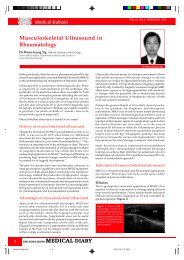MEDICAL DIARY - The Federation of Medical Societies of Hong Kong
MEDICAL DIARY - The Federation of Medical Societies of Hong Kong
MEDICAL DIARY - The Federation of Medical Societies of Hong Kong
You also want an ePaper? Increase the reach of your titles
YUMPU automatically turns print PDFs into web optimized ePapers that Google loves.
12<br />
<strong>Medical</strong> Bulletin<br />
Antiplatelet <strong>The</strong>rapy for Atherothrombotic<br />
Diseases<br />
Dr. Wai-hong Chen<br />
MBBS (HK), MRCP (UK), FHKCP, FHKAM (Medicine)<br />
Specialist in Cardiology<br />
Abstract: Atherothrombosis describes the formation <strong>of</strong><br />
a thrombus on a disrupted atherosclerotic plaque, and<br />
is the primary cause <strong>of</strong> acute ischaemic events.<br />
Atherothrombosis is a generalised and progressive<br />
process with an inflammatory component. Patients with<br />
disease in one vascular bed are at risk <strong>of</strong> disease in<br />
another. Platelet adhesion, activation, and aggregation<br />
in the final stage <strong>of</strong> atherothromobosis are responsible<br />
for arterial occlusion and consequent ischaemia.<br />
<strong>The</strong>refore antiplatelet therapy is an effective treatment<br />
choice for secondary prevention. Clopidogrel, an<br />
adenosine diphosphate receptor antagonist, given alone<br />
or in combination with aspirin, may benefit secondary<br />
prevention <strong>of</strong> ischaemic events. Current treatment<br />
guidelines suggest the use <strong>of</strong> combination <strong>of</strong> these two<br />
agents for secondary prevention where appropriate.<br />
However, data conflict regarding the efficacy <strong>of</strong><br />
antiplatelet therapy for primary prevention. A recent<br />
meta-analysis demonstrated that aspirin significantly<br />
reduces the risk <strong>of</strong> first myocardial infarction in both<br />
men and women. <strong>The</strong> recent Clopidogrel for High<br />
Atherothrombotic Risk and ischemic Stabilization<br />
Management, and Avoidance trial, (CHARISMA) which<br />
evaluated the effects <strong>of</strong> clopidogrel plus aspirin<br />
compared with aspirin alone, seems to support the use<br />
<strong>of</strong> dual antiplatelet therapy in secondary prevention,<br />
but suggests that it may not be more effective than<br />
aspirin alone in primary prevention.<br />
Key Words: atherothrombosis, aspirin, clopidogrel,<br />
antiplatelets, cardiovascular disease<br />
Atherothrombosis, the unhealthy coupling <strong>of</strong><br />
atherosclerosis and thrombosis, is the most common<br />
cause <strong>of</strong> acute ischaemic events. <strong>The</strong> underlying<br />
atherosclerotic process is diffuse, generalised, and<br />
progressive, affecting multiple vascular beds. This<br />
leads to a number <strong>of</strong> clinical manifestations, the natures<br />
<strong>of</strong> which are influenced by the target organ and specific<br />
vascular bed involved. Ischaemic events related to<br />
atherothrombosis include coronary, cerebral, and<br />
peripheral arterial disease (PAD).<br />
Disease in one vascular bed increases the risk <strong>of</strong> disease<br />
in other, a concept known as "cross-risk." 2-3 In the<br />
Reduction <strong>of</strong> Atherothrombosis for Continued Health<br />
(REACH) Registry, which included a total <strong>of</strong> 67,888<br />
patients from 44 countries, 15.9% <strong>of</strong> the 55,499 with<br />
symptomatic atherothrombosis had polyvascular<br />
disease, defined as at least 2 <strong>of</strong> the following: coronary<br />
artery disease (CAD), PAD, and cerebrovascular<br />
disease. 4 <strong>The</strong>se patients, who tend to be older and have<br />
VOL.14 NO.1 JANUARY 2009<br />
Dr. Wai-hong Chen<br />
more comorbidities, had higher rates <strong>of</strong> cardiovascular<br />
outcomes after 1 year <strong>of</strong> follow-up compared with<br />
patients with vascular disease in a single bed. 5 Patients<br />
with one ischaemic event have an increased likelihood <strong>of</strong><br />
experiencing another event in the future. A 7-year<br />
population-based study showed that, compared with<br />
patients who had no history <strong>of</strong> myocardial infarction<br />
(MI), those who had experienced a prior MI had<br />
significantly increased risks <strong>of</strong> stroke (1.9 % versus 7.2 %)<br />
and death from cardiovascular causes (2.1 % versus 15.9<br />
%) ,in addition to an increased risk <strong>of</strong> recurrent MI (3.5 %<br />
versus 18.8 %). 6 Similarly, a community-based study <strong>of</strong><br />
patients with a first stroke demonstrated that among<br />
those who survived the first 30 days after the initial<br />
events, other cardiovascular events accounted for<br />
approximately the same proportion <strong>of</strong> deaths (26 %) as<br />
the initial stroke (27%) during the following 10 years. 7<br />
Secondary prevention is therefore necessary in all<br />
patients with a history <strong>of</strong> ischaemic events.<br />
Management <strong>of</strong> ischaemic risk factors, through a<br />
combination <strong>of</strong> lifestyle modifications and<br />
pharmacotherapy, reduces the incidence <strong>of</strong> ischaemic<br />
events. 8 <strong>The</strong>re are a number <strong>of</strong> pharmacological<br />
agents useful for primary and secondary prevention;<br />
this review will focus on the role <strong>of</strong> antiplatelet agents<br />
in the prevention <strong>of</strong> atherothrombotic events in<br />
patients at high risk.<br />
Pathophysiology <strong>of</strong> Atherothrombosis<br />
<strong>The</strong> pathogenesis <strong>of</strong> atherothrombosis is a complex<br />
process that can be divided into 5 phases, with<br />
inflammation playing a key role. 1,9,10 Indeed,<br />
atherosclerosis and atherothrombosis are currently<br />
viewed as inflammatory disorders. 11 Atherosclerotic<br />
plaque rupture heralds the activation <strong>of</strong> haemostasis,<br />
involving platelets and the coagulation system. Under<br />
the high shear flow <strong>of</strong> a ruptured plaque, platelets may<br />
adhere directly to von Willebrand factor (vWF) and the<br />
activated endothelium, initiating the process <strong>of</strong> platelet<br />
activation. Platelets undergo a series <strong>of</strong> important events<br />
during activation, including: (1) shape change from a tiny<br />
disc to sphere with extending filopodiae; (2) activation <strong>of</strong><br />
the surface glycoprotein IIb/IIIa receptor, the ultimate<br />
path to platelet aggregation; and (3) the release <strong>of</strong><br />
vasoactive (eg, thromboxane A 2, serotonin, plateletactivating<br />
factor), pro-aggregant [eg, adenosine<br />
diphosphate (ADP), vWF], and pro-coagulant (e.g.<br />
thrombin, tissue factor) substances from platelet<br />
granules. After initial activation, potent amplification

















